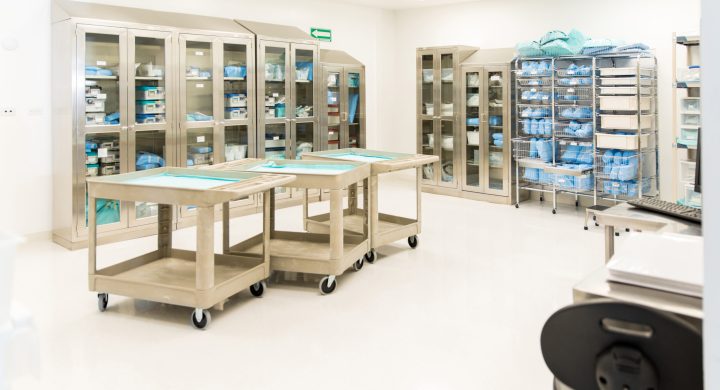
Infection control in hospitals is essential, helping prevent hospital-acquired infections (HAI), protecting vulnerable individuals, and maintaining a safe environment for frontline workers.
With nearly 100,000 deaths and $28 billion in extra expenses on the line, hospital decision-makers have every reason to ensure their disinfection protocols go above and beyond the call of duty.
However, while effective in eradicating pathogens, the chemicals commonly used for advanced disinfection like bleach and hydrogen peroxide carry a host of risks and externalities that are often overlooked in the name of expediency.
It’s time we reassess our conventional approach to disinfection. Keep reading to learn more about the adverse health effects associated with commonly used disinfectants and the safe, effective solution that can keep patients and personnel safe without compromise.
The Hazardous Reality of Commonly Used Disinfectants
Bleach and hydrogen peroxide effectively combat harmful pathogens and ensure a sterile environment. They also pose health and environmental risks that can harm the frontline workers who use them regularly.
For instance, a study published in JAMA unveiled an alarming connection between the regular use of disinfectants and the development of chronic obstructive pulmonary disease (COPD) among female healthcare workers. The research suggests that frontline workers with “occupational exposure to cleaning products and disinfectants were significantly associated with a 25% to 38% increased risk of developing chronic obstructive pulmonary disease independent of asthma and smoking.”
As the study’s authors conclude, “These longitudinal results suggest that regular use of chemical disinfectants among nurses may be a risk factor for developing COPD.”
In a separate report published by the National Library of Medicine, researchers analyzed ten studies, concluding that a “Meta‐analysis of 10 studies evaluating the association between occupational cleaning exposures and asthma demonstrated a 35% increased risk in exposed hospital workers.”
The researchers added, “The results suggest a need for preventive practices to reduce the risk of asthma and asthma‐like symptoms in hospital workers exposed to occupational cleaning/disinfecting agents.”
While these findings don’t unequivocally prove that these disinfectants cause COPD, they do highlight a concerning correlation between regular disinfectant use and the disease’s onset. At the same time, these chemicals are corrosive and harmful to the environment, making the long-term costs and consequences of outdated disinfection methodologies extremely high.
In the U.S. healthcare system, the duty of applying these chemicals most often falls on the Environmental Services Staff (EVS) and nursing staff. This essential yet often overlooked group is routinely exposed to these toxic chemicals, underscoring the urgent need for safer, more sustainable alternatives.
HOCl: Disinfection Without Compromise
While bleach and hydrogen peroxide present potential harms in the cleaning process, Hypochlorous acid (HOCl) stands out as a non-toxic, yet highly effective disinfection option in a hospital or healthcare environment.
HOCl is a natural but incredibly powerful disinfectant that’s non-toxic, making it an ideal candidate for wide-ranging applications in healthcare settings.
Unlike traditional disinfectants, HOCl poses minimal risk to patients, healthcare workers, or the environment. Its non-toxic nature makes it safe for use around patients, including those with compromised immune systems or respiratory conditions, where traditional disinfectants may pose a threat.
Moreover, HOCl is gentle on equipment. It doesn’t cause corrosion or degradation, extending the lifespan of medical instruments and reducing the need for frequent replacements.
This not only leads to cost savings for healthcare facilities but also decreases the environmental burden associated with the production and disposal of medical equipment. Additionally, HOCl is safe for the environment. It breaks down into harmless byproducts, eliminating the concern of harmful residues or environmental contamination associated with traditional disinfectants.
HOCl provides a paradigm shift in our approach to disinfection. It is the most powerful oxidant in the chlorine family, outperforming bleach or hydrogen peroxide-based cleaners across various metrics. Specifically, HOCl is:
- 80x-100x more effective than bleach
- pH neutral (similar to milk/human tears)
- Nontoxic, safe, gentle on surfaces
- Neutral charge: does not repel bacteria, but attracts them
- Zero bacterial resistance
- Environmentally safe, naturally occurring.
HOCl offers all the benefits of traditional disinfectants – killing bacteria, viruses, and other harmful pathogens – without the associated risks.
Stepping into a Safer Future with HOCl
The research is clear, and the stakes are high: The time to reassess our approach to disinfection in healthcare settings is now. The use of traditional disinfectants presents not only a risk to our environment but also a significant threat to the health of our frontline workers who are exposed to these toxic chemicals daily.
Awareness alone won’t bring about the needed change. It’s time to translate this knowledge into action. It’s time to prioritize not just efficiency in disinfection but also the health of our workers and patients, along with the sustainability of our practices.
Nevoa is at the forefront of this change, providing HOCl-based disinfection solutions that are both highly effective and environmentally friendly. Our fogging disinfection products are designed to protect people and the planet without compromising quality or effectiveness.
To learn more about how Nevoa’s products can enhance safety and sustainability in your healthcare setting, visit http://www.nevoainc.com/ or contact us today.
Let’s work together to create a healthier, safer, and greener future for our healthcare industry.
